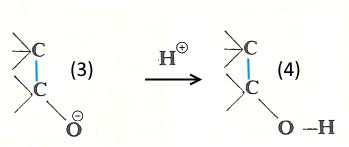





 Victor Grignard 1871-1935
Victor Grignard 1871-1935
It is added in an absolutely dry flask - Freshly crushed magnesium turnings (no surface layer!) - A solution of an alkyl bromide ($R-Br$ ) in dry ether previously dried on sodium It is very moderately heated. The reaction starts only in absolutely anhydrous medium! If it does not start, add a few crystals of iodine that produce magnesium iodide which is very greedy for water.
Part of a video due to University of Toronto Scarborough
The reaction product is then separated from the ether. This is the alkylmagnesium bromide, an organomagnesium compound: $R-Br+Mg$ $\rightarrow$ $R-MgBr$
In a simplified way, one can say that the magnesium alkyl bromide tends to dissociate in the presence of an electrophilic center $ \delta + $ to form the powerful nucleophilic carbanion $ R- $ $R-MgBr\rightarrow R^- + MgBr^+$
The $ C $ atom of the carbonyl is an electrophilic center, so we have the attack:

A new $ C-C $ bond has been formed! Then adding a dilute acid, a hydroxyl group is obtained:

Find the final substances obtained (by following the above steps) from the reactants: - bromoethane and pentan-3-one →
- bromopropane and ethanal →
- bromobenzene and methanal →